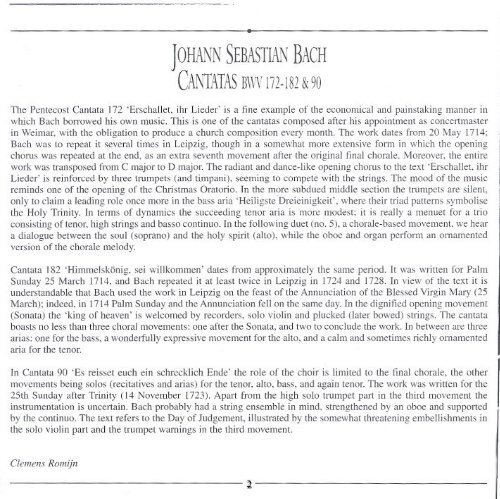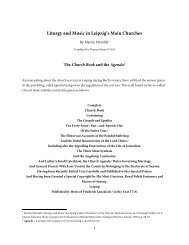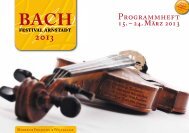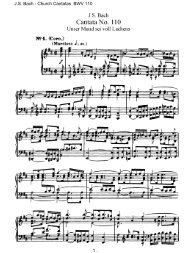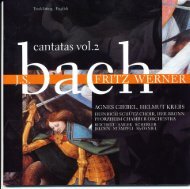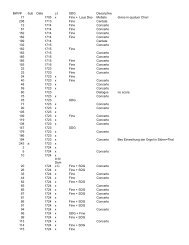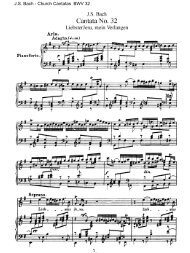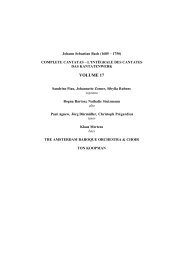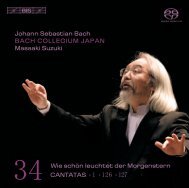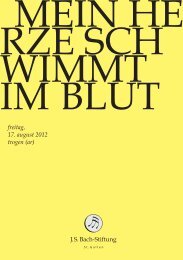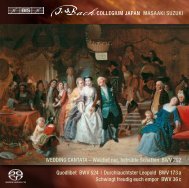Bach Cantatas, Vol. 3 - P.J. Leusink (Brilliant Classics 5-CD)
Bach Cantatas, Vol. 3 - P.J. Leusink (Brilliant Classics 5-CD)
Bach Cantatas, Vol. 3 - P.J. Leusink (Brilliant Classics 5-CD)
You also want an ePaper? Increase the reach of your titles
YUMPU automatically turns print PDFs into web optimized ePapers that Google loves.
JOHANNSEBASTIAN BACH<br />
CANTATASBWV 172-182 &90<br />
The PentecostCantata 172 'Erschallet, ihr Lieder' isa fineexample of theeconomical and painstaking mannerin<br />
which <strong>Bach</strong> bOlTOwedhis own music.This is oneof the cantatas composed after his appointment asconcertmaster<br />
in Weimar,with the obligation to produce a church composition every month.The work dates from 20 May 1714;<br />
<strong>Bach</strong> wasto repeat it several times in Leipzig, though in a somewhatmore extensive form in whichthe opening<br />
chorus was repeated at the end, as an extra seventhmovement after the original final chorale. Moreover,the entire<br />
work was trdDsposedfrom C major 10D major.The mdianl and dance-like opening chorus to the text 'Erschallet, ihr<br />
Lieder' is reinforcedby three trumpets(andtimpani), seeming tocompete with the strings.The moodof lhe music<br />
reminds oneof the openingof the ChristmasOratorio. Inthe more subdued middle sectionthe trumpets are silent,<br />
only to claim a leadingroleonce morein the bass aria 'Heiligste Dreieinigkeit', wheretheir triadpatterns symbolise<br />
the Holy Trinity. Interms ofdynamics the succeeding tenor aria is morc modest; it isreally a menuet for a trio<br />
consisting of tenor,high stringsand bassocontinuo. In the following duet (no. 5). a chorale-based movement, we hear<br />
a dialogue between the soul (soprano)and theholy spirit(alto), while the oboe and organ performan ornamented<br />
version of the chorale melody.<br />
Cantata 182 'Himmelskonig, sei willkommen' dates from approximately thesame period. It waswritten for Palm<br />
Sunday 25 March 1714,and <strong>Bach</strong> repeated it at least twice in Leipzig in 1724and 1728.In viewof the text it is<br />
understandable that <strong>Bach</strong> usedthe work in Leipzig on the feast of theAnnunciation of the BlessedVirginMary (25<br />
March); indeed, in 1714Palm Sunday and the Annonciationfell on the same day. Inthe dignified opening movement<br />
(Sonata)the 'king of heaven' is welcomed by recorders, solo violinand plucked(later bowed) strings.The cantata<br />
boasts no less thanthree choral movements:one after the Sonata, andtwo toconclude the work. Inbetween arc three<br />
arias: one for the bass, a wonderfully expressivemovementfor the alto, and a calmand sometimes richly ornamented<br />
aria for the tenor.<br />
In Cantata 90 'Es reisset euch ein schrecklich Ende' the role of the choir is limited to the final chorale, the other<br />
movements being solos (recitatives and arias) for the tenor, alto, bass, and again tenor. The work was wrinen for the<br />
25th Sunday after Trinity (14 November 1723). Apart from the high solo trumpet part in the third movement the<br />
instrumentation is uncertain. <strong>Bach</strong> probably had a string ensemble in mind, strengthened byan oboe and supported<br />
by the continuo. The lext refers to the Day ofJudgement, illustrated bythe somewhat threatening embellishments in<br />
the solo violin part and thetrumpet warnings inthe third movement.<br />
Clemen.r Romijn<br />
2


